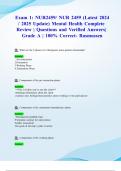ExamI1:INUR2459/INURI2459I(LatestI2024
/I2025IUpdate)IMentalIHealthICompleteI
ReviewI|IQuestionsIandIVerifiedIAnswers|I
GradeIAI|I100%ICorrect-IRasmussen
Q:IWhatIareItheI4IphasesIofIaItherapeuticInurse-patientIrelationship?
Answer:
I1.Pre-Interaction
2.Orientation
3.WorkingIPhase
4.TerminationIPhase
Q:IComponentsIofItheIpreIinteractionIphase
Answer:
I**ThisIisIbeforeIyou'veImetItheIclient**
-obtainingIinformationIaboutItheIclient
-examineIonesIfeelings/fears/anxietiesIaboutIworkingIw/ItheIparticularIpt
Q:IComponentsIofItheIorientationI(introductory)Iphase
Answer:
I•Introduction/establishItrust
•FormulateIcontractIforIintervention
•GatherIassessment
•SetIgoalsI&IdevelopIaIplanIofIaction
Q:IComponentsIofItheIworkingIphase
Answer:
,I•MaintainItrustI&Irapport
•OvercomeIresistanceIbehaviors
•Re-evaluateIprogressItowardIgoals
I
Q:IComponentsIofItheIterminationIphase
Answer:
I•ProgressIhasIbeenImadeItowardIattainmentIofIsetIgoals
•PlanIforIcontinuingIcareIisIestablished
•TheItherapeuticIrelationshipIisIterminatedI(clientImayIexperienceIaIsenseIofIloss)
Q:IJustIasIaIsocialIrelationshipsIdifferIfromItherapeuticIrelationships,IbasicIcommunicationIis
IdifferentIfromIprofessional,Igoal-
directed,I&IscientificallyIbasedIcommunicationIwhichIisIreferredItoIasIwhat?
Answer:
ITherapeuticICommunica-Ition
Q:IHorowitzIdescribesIculturalIinfluencesIthatIaffectIhowIindividualsIviewImentalIillness,Ithe
yIare?
Answer:
IIncomprehensibility:ItheIabilityIofItheIgeneralIpopulationItoIunderstandItheImotivationIbehind
ItheIbehavior
CulturalIRelativity:ITheI"normality"IofItheIbehaviorIasIdeterminedIbyItheIculture
Q:IWhatIisImentalIillness?
Answer:
IMIIisIcharacterizedIasImaladaptiveIresponsesItoIstressorsIfromIinternalIorIexternalIenvironme
nt,IevidencedIbyIthoughts,IfeelingsI&IbehaviorsIthatIareIincongruentIw/ItheIlocalI&IculturalIn
ormsIandIthatIinterfereIw/ItheIindividualsIsocial,IoccupationalIand/orIphysicalIfunctioning.
,Q:IWhatIareItheIstagesIofIanxiety?
Answer:
IMild
ModerateISevereIPanic
Q:ICharacteristicsIofImildIanxiety
Answer:
I•IOccursIinItheInormalIexperienceIofIevery-IdayIliving.
•IItIincreasesIone'sIabilityItoIperceiveIreality.
•IThereIisIanIidentifiableIcauseIofItheIanxiety.
•IOtherIcharacteristicsIincludeIaIvagueIfeelingIofImildIdiscomfort,Irestlessness,Iirritability,Iimp
atience,
andIapprehension.
•ITheIclientIcanIexhibitImildItension-relievingIbehaviors
(finger-IorIfoot-tapping,Ifidgeting,Ilip-chewing).
Q:ICharacteristicsIofImoderateIanxiety
Answer:
I•IOccursIwhenImildIanxietyIescalates.
•ISlightlyIreducedIperceptionIandIprocessingIofIinformationIoccurs,IandIselectiveIinattentionIc
anIoccur.
•IAbilityItoIthinkIclearlyIisIhampered,IbutIlearningIandIproblem-solvingIcanIstillIoccur.
•IOtherIcharacteristicsIincludeIconcentrationIdifficulties,Itiredness,Ipacing,IchangeIinIvoiceIpitc
h,IvoiceItremors,Ishakiness,IandIincreasedIheartIrateIandIrespiratoryIrate.
•ITheIclientIcanIreportIsomaticImanifestationsIincludingIheadaches,Ibackache,IurinaryIurgency
IandIfrequency,
I
andIinsomnia.
•ITheIclientIwhoIhasIthisItypeIofIanxietyIusuallyIbenefitsIfromItheIdirectionIofIothers.
Q:ICharacteristicsIofIsevereIanxiety
, Answer:
I•IPerceptualIfieldIisIgreatlyIreducedIwithIdistortedIperceptions.
•ILearningIandIproblem-solvingIdoInotIoccur.
•IFunctioningIisIineffective;IbehaviorsIareIautomatic.
•IOtherIcharacteristicsIincludeIconfusion,IfeelingsIofIimpendingIdoom,Ihyperventilation,Itachy
cardia,Iwithdrawal,IloudIandIrapidIspeech,IandIaimlessIactivity.
•ITheIclientIwhoIhasIsevereIanxietyIusuallyIisInotIableItoItakeIdirectionIfromIothers.
Q:ICharacteristicsIofIpanicIanxiety
Answer:
I•ICharacterizedIbyImarkedlyIdisturbedIbe-Ihavior.
•ITheIclientIisInotIableItoIprocessIwhatIisIoccurringIinItheIenvironmentIandIcanIloseItouchIwit
hIreality.
•ITheIclientIexperiencesIextremeIfrightIandIhorror.
•ITheIclientIexperiencesIsevereIhyperactivity,Iflight,IorIimmobility.
•IOtherIcharacteristicsIcanIincludeIdysfunctionIinIspeech,
dilatedIpupils,IsevereIshakiness,IsevereIwithdrawal,IinabilityItoIsleep,Idelusions,IandIhallucinat
ions.
Q:INursingIinterventionsIforImildItoImoderateIanxiety
Answer:
I•UseIactiveIlisteningItoIdemonstrateIwillingnessItoIhelp,IandIuseIspecificIcommunicationItech
niques
(openIIIendedIquestions,IgivingIbroadIopenings,Iexploring,IandIseekingIclarification).
•ProvideIaIcalmIpresence,IrecognizingItheIclient'sIdistress.
•EvaluateIpastIcopingImechanisms.
•ExploreIalternativesItoIproblemIsituations.
•EncourageIparticipationIinIactivities,IsuchIasIexerciseIthatIcanItemporarilyIrelieveIfeelingsIofI
innerItension.
Q:INursingIinterventionsIforIsevereItoIpanicIanxiety
Answer:
I•ProvideIanIenvironmentIthatImeetsItheIphysicalIandIsafetyIneedsIofItheIclient.IRemainIwithIt
heIclientIandIremainIcalm.




